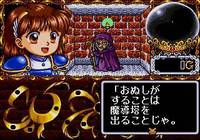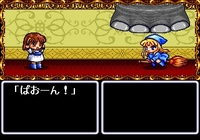|
|

|
PLATFORM
|
Genesis
|
BATTLE SYSTEM
|

|
INTERACTION
|

|
ORIGINALITY
|

|
STORY
|

|
MUSIC & SOUND
|

|
VISUALS
|

|
CHALLENGE
|
Very Easy
|
COMPLETION TIME
|
Less than 20 Hours
|
|
OVERALL

|
+ Unique and entertaining combat system
+ Import-friendly
- Number-phobic mechanics
- Fairly repetitive and easy
|
Click here for scoring definitions
|
|
|
The venerable Sega Genesis was on its last legs in 1996, with comparatively little new software released for it. Off in Japan, the Mega Drive was hardly in a better situation, but still had a few titles released that did not make it across the Pacific. One that would have enlivened the situation across the Pacific a bit is Madou Monogatari I, a remake of Compile's RPG series from the late 80's. Madou Monogatari II and III never surfaced on the Mega Drive, making the game's title a bit misleading. As a means of experiencing Arle Nadja's pre-Puyo Puyo career, however, this is a respectable choice.
Arle's adventure takes the form of a dungeon crawl through a large tower. This precocious five year old is wandering around in a place full of goofy-looking but dangerous opponents because it is a test of her abilities. Reaching the top will prove that her magic school training is a success. There are quick sequences involving a couple of other magic school students in the tower (played for laughs), and some other quick scenes where Arle learns new spells from the tower's denizens. Madou Monogatari's charm as a series is the only thing of interest in the plot, and it is not the reason to play this game.
Arle wanders the tower with a first-person perspective, engaging its unfriendly inhabitants in one-on-one random battles. Pressing right will send Arle out to smack enemies physically, pressing left will make her block incoming attacks to reduce their damage, and up or down will make her try to avoid the attacks altogether by dodging. The B button opens the item menu, and the C button will make Arle try to run away. Holding down the A button and inputting various motions reminiscent of fighting games will produce spells from Arle, and these are a much better means of defeating opponents. It is the A button that will probably see the most use in battles, because Arle is five and her physical attacks are not very strong. Pressing the start button will bring up all the spells Arle knows, in case a reminder is needed during combat.
 Arle looks happy, and you want to keep her that way.
Arle looks happy, and you want to keep her that way.
|
|
Experience and money are awarded upon defeating each enemy, but Madou Monogatari I has no number value for the experience. Instead a shiny brooch design that takes up the bottom half of the screen outside of combat slowly fills up, and when every sparkly icon it contains is full, Arle levels up. There is no means of ascertaining what level Arle is either, unless one has a very good memory. Arle has no hit points or magic points either. Her face is prominently displayed outside of battle, and her expression ranges from incredibly happy to Looney Tunes-esque spinning eyes as a means of gauging her health. Inside battle close attention must be paid to her sprite's expression, which is hard to do but is the only means of knowing whether Arle is being hurt badly. Magic points have another system entirely, one in which the game uses an emoticon after each spell use to show how much mana Arle still has. This system is alternately cute and annoying.
Inventory management is quite simple save for one irritating aspect, the inability to call up the spell list outside of battle. There are instances in which the casting of a spell on something in the environment is necessary to proceed, and fiddling around aimlessly with every possible D-pad motion to produce spells that are not used much is not much fun. There are no weapons or armor to equip. Items are easy to use but the limit of 27 that can be held means plenty of instances where something must be discarded. Pressing the C button at any time outside of battle will call up a map of the current floor and all other floors that have been explored, which is very handy and alleviates much potential frustration.
Madou Monogatari I's visuals are quite good, as would be expected from a game released at the end of the Sega Genesis's life. All enemies are well-animated and Arle's spells have a multitude of visuals. What limits the visual score is the fact that the game takes place inside a tower - though the walls do change appearance on certain floors, there are still only about half a dozen different aspects to the surroundings. The environs of the game limit the music too, with one theme playing for the majority of the tower. Its underground floors and the top have different themes, which are very welcome. Aside from the limited quantity of music, Arle has plenty of things to say aloud and every enemy has a couple of vocal clips to be heard, with all of them being clear enough to understand.
 An elephant crushing that poor witch beneath its foot? Anything goes!
An elephant crushing that poor witch beneath its foot? Anything goes!
|
|
Simply completing the game will not require much Japanese skill, as there are no puzzles while climbing the tower that trial-and-error cannot take care of. Enemies do get stronger as the game continues, and a few near the end can kill Arle very quickly, but the ability to save anywhere ameliorates potential frustration. The final bosses are much harder than anything else in the game because of their enormous power and speed. To obtain a different ending, Arle must solve a number of simple puzzles throughout the tower that are made less simple because of their being in Japanese. The entire game can probably be completed in under 20 hours, though the lack of a game clock makes this only an estimate.
The first Madou Monogatari exists in several versions, but none of the others abandons turn-based battling. The game is not a rousing success thanks to its self-imposed limitations in setting and repetitive nature. It is not a failure either, and the limited competition on the Sega Genesis in 1996 would probably have made for a fairly popular localization. Its charms have weathered the intervening years rather well, and since it is not difficult to locate a modest recommendation can be made on its behalf.
Review Archives
|









